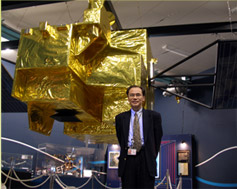
Q. Why do you think that a satellite like GOSAT is now in demand?
It seems to me that it's the natural course of history. There have been many studies of greenhouse gases since about 1920. Many scientists were interested in the issues even when the technology to monitor greenhouse gases with spacecraft didn't exist. Having the technology now, it's finally time for us to use it. In the meantime, public concern about greenhouse gases has also grown, and has inspired JAXA to make further international contributions with its own technology. And GOSAT is the result. I don't have the impression that it is a big leap, but rather that all the efforts made over time have finally taken shape so we can finally do something for the world.

Project Manager Hamazaki with a GOSAT full-scale model
Q. How are you feeling about the launch in the summer?
We just started testing the flight model. I am under daily pressure hoping for a successful mission, but at the same time I'm confident about the great contributions GOSAT will make. Therefore I have a mixed feeling of tension and excitement. I also feel very committed to saving the world. It makes me blush to say this, but I have a strong sense that I'm working for global peace. Of course, GOSAT itself cannot stop global warming, but instead of just alarming about it, the most practical thing to do now is to use GOSAT observation data to get an appropriate knowledge of the current status of the planet, so we can work on preventive measures. Therefore I'd like to ensure that its data will be distributed as quickly as possible, to encourage and contribute to greenhouse-gas reduction. My current focus is on launching the satellite as scheduled in 2008.
Born in 1954, Mr. Hamazaki started his career in 1979 at NASDA, the National Space Development Agency of Japan (now JAXA). He has worked in the Systems Planning Department, and the Satellite Design Technology Laboratory. He also has been stationed at NASA as a Government of Japan Liaison for the International Space Station Program, and was a deputy project manager for the Advanced Land Observing Satellite (ALOS). He has been in his current position since 2003.